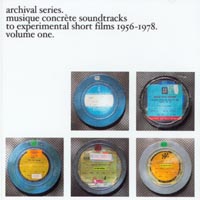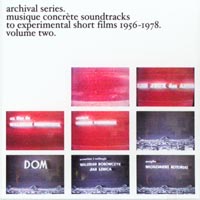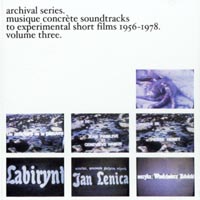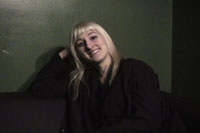"Musique Concrète Soundtracks To Experimental Short Films 1956-1978"
In the 21st century, audio preservation and restoration will become ahot topic. I believe it's going to be a struggle as copyright owners(both private and corporate) will be the main factors of lettingmusical works die. I fear history will only be recorded for the mostpopular icons of the most popular western music genres. Thankfully,there's a small number out there who aren't willing to accept that.These first three CDs in this series exemplify what I consider'guerilla preservation'. The music that appears on these compilationshas been mastered from both 16mm prints and first-generationvideotapes, illegally, with a host of mysterious credits.
First of all,whoever's been doing them has been physically just dropping them off atthe local Cambridge store, Twisted Village. Next, the music is creditedto being mastered by Theaddeus Cahill at the New England ElectronicMusic Company in Holyoke, MA. Cahill actually invented what manyconsider to be the first electronic instrument, the Telharmonium (click here)and had worked on creating these huge beasts at the factory in Holyokearound the last turn of the century. It's an ominous reference topreservation of electronic music as no sounds from the Telharmoniumhave survived. (Sadly, the last existing Telharmonium was sold forscrap by his brother when nobody was willing to buy it.) Finally,special thanks go out to people like Alan Smithee (a non-existant manwho film directors choose to go as when a film company decides todestroy their film beyond the director's intent).
 The music on the first disc is pulled from five shorts, opening with the music from 1958's 'Glas'by Tom Dissevelt which is easily a blueprint for early Cabaret Voltairemusic with tape manipulation, found sounds and hypnotic vocal loops.The music from 'Pixillation' is from 1971 and uses a healthy balance ofrhythmic analogue synths, lead organ and various percussion. It's byGershon Kingsley, composer of the theme to TV game show "The Joker'sWild"! The spacey drones on 'Free Music' by Perry Grainger accompaniesdialogue about space exploration which could easily pop up on a JackDangers 'Sounds of the 20th Century' series while Pierre Boulez''Symphonic Mechanique' from 1956 is full of Stockhausen-esque audiomanipulations, accented with piano, bass, and xylophone sounds. VolumeOne concludes with, "Dance Frame" with music by Joan LaBarbara, usingnightmarish vocals and an equally creepy bed of noise.
The music on the first disc is pulled from five shorts, opening with the music from 1958's 'Glas'by Tom Dissevelt which is easily a blueprint for early Cabaret Voltairemusic with tape manipulation, found sounds and hypnotic vocal loops.The music from 'Pixillation' is from 1971 and uses a healthy balance ofrhythmic analogue synths, lead organ and various percussion. It's byGershon Kingsley, composer of the theme to TV game show "The Joker'sWild"! The spacey drones on 'Free Music' by Perry Grainger accompaniesdialogue about space exploration which could easily pop up on a JackDangers 'Sounds of the 20th Century' series while Pierre Boulez''Symphonic Mechanique' from 1956 is full of Stockhausen-esque audiomanipulations, accented with piano, bass, and xylophone sounds. VolumeOne concludes with, "Dance Frame" with music by Joan LaBarbara, usingnightmarish vocals and an equally creepy bed of noise.
 The second and third volumes only feature two pieces each. With thesetracks stretching to about 10 minutes on average, the music is arguablymore thematic and compositional in nature than the shorter tracks onvolume one. Pierre Henry's music to 'Les Amours de la Pleuvre' isremeniscent of church music with the occasional vocal loop whileWlodzimierz Kotonski's music for Jan Lenica's 'Labyrinthe' is a playfulcartoon-esque pitch-twisting dementia of percussives, pianos andunrecognizables with calliope. Kotonski appears on volume three withtwisted piece, this time a morse code and noises-enhanced gloomy bitfrom the 1957 animated short by Jan Lenica with Walerian Borowczyk,'Dom'. The other piece on volume three is music from the 1964 film'Jeux des Angels' with French dialogue, audio manipulations,xylophones, and various other noisemakers that would probably make anyfan of Nurse With Wound's 'Sylvie and Babs' quiver. These collectionsare truly fascinating and eye-opening and I'm anxious to find morevolumes. I hope the real Thaddeus Cahill (who died in 1934) is proudthat his name and company are being name-checked so respectfully andwhoever's putting these things out keep it going. Twisted Village'swebsite is www.twistedvillage.com.
The second and third volumes only feature two pieces each. With thesetracks stretching to about 10 minutes on average, the music is arguablymore thematic and compositional in nature than the shorter tracks onvolume one. Pierre Henry's music to 'Les Amours de la Pleuvre' isremeniscent of church music with the occasional vocal loop whileWlodzimierz Kotonski's music for Jan Lenica's 'Labyrinthe' is a playfulcartoon-esque pitch-twisting dementia of percussives, pianos andunrecognizables with calliope. Kotonski appears on volume three withtwisted piece, this time a morse code and noises-enhanced gloomy bitfrom the 1957 animated short by Jan Lenica with Walerian Borowczyk,'Dom'. The other piece on volume three is music from the 1964 film'Jeux des Angels' with French dialogue, audio manipulations,xylophones, and various other noisemakers that would probably make anyfan of Nurse With Wound's 'Sylvie and Babs' quiver. These collectionsare truly fascinating and eye-opening and I'm anxious to find morevolumes. I hope the real Thaddeus Cahill (who died in 1934) is proudthat his name and company are being name-checked so respectfully andwhoever's putting these things out keep it going. Twisted Village'swebsite is www.twistedvillage.com.

First of all,whoever's been doing them has been physically just dropping them off atthe local Cambridge store, Twisted Village. Next, the music is creditedto being mastered by Theaddeus Cahill at the New England ElectronicMusic Company in Holyoke, MA. Cahill actually invented what manyconsider to be the first electronic instrument, the Telharmonium (click here)and had worked on creating these huge beasts at the factory in Holyokearound the last turn of the century. It's an ominous reference topreservation of electronic music as no sounds from the Telharmoniumhave survived. (Sadly, the last existing Telharmonium was sold forscrap by his brother when nobody was willing to buy it.) Finally,special thanks go out to people like Alan Smithee (a non-existant manwho film directors choose to go as when a film company decides todestroy their film beyond the director's intent).
 The music on the first disc is pulled from five shorts, opening with the music from 1958's 'Glas'by Tom Dissevelt which is easily a blueprint for early Cabaret Voltairemusic with tape manipulation, found sounds and hypnotic vocal loops.The music from 'Pixillation' is from 1971 and uses a healthy balance ofrhythmic analogue synths, lead organ and various percussion. It's byGershon Kingsley, composer of the theme to TV game show "The Joker'sWild"! The spacey drones on 'Free Music' by Perry Grainger accompaniesdialogue about space exploration which could easily pop up on a JackDangers 'Sounds of the 20th Century' series while Pierre Boulez''Symphonic Mechanique' from 1956 is full of Stockhausen-esque audiomanipulations, accented with piano, bass, and xylophone sounds. VolumeOne concludes with, "Dance Frame" with music by Joan LaBarbara, usingnightmarish vocals and an equally creepy bed of noise.
The music on the first disc is pulled from five shorts, opening with the music from 1958's 'Glas'by Tom Dissevelt which is easily a blueprint for early Cabaret Voltairemusic with tape manipulation, found sounds and hypnotic vocal loops.The music from 'Pixillation' is from 1971 and uses a healthy balance ofrhythmic analogue synths, lead organ and various percussion. It's byGershon Kingsley, composer of the theme to TV game show "The Joker'sWild"! The spacey drones on 'Free Music' by Perry Grainger accompaniesdialogue about space exploration which could easily pop up on a JackDangers 'Sounds of the 20th Century' series while Pierre Boulez''Symphonic Mechanique' from 1956 is full of Stockhausen-esque audiomanipulations, accented with piano, bass, and xylophone sounds. VolumeOne concludes with, "Dance Frame" with music by Joan LaBarbara, usingnightmarish vocals and an equally creepy bed of noise.  The second and third volumes only feature two pieces each. With thesetracks stretching to about 10 minutes on average, the music is arguablymore thematic and compositional in nature than the shorter tracks onvolume one. Pierre Henry's music to 'Les Amours de la Pleuvre' isremeniscent of church music with the occasional vocal loop whileWlodzimierz Kotonski's music for Jan Lenica's 'Labyrinthe' is a playfulcartoon-esque pitch-twisting dementia of percussives, pianos andunrecognizables with calliope. Kotonski appears on volume three withtwisted piece, this time a morse code and noises-enhanced gloomy bitfrom the 1957 animated short by Jan Lenica with Walerian Borowczyk,'Dom'. The other piece on volume three is music from the 1964 film'Jeux des Angels' with French dialogue, audio manipulations,xylophones, and various other noisemakers that would probably make anyfan of Nurse With Wound's 'Sylvie and Babs' quiver. These collectionsare truly fascinating and eye-opening and I'm anxious to find morevolumes. I hope the real Thaddeus Cahill (who died in 1934) is proudthat his name and company are being name-checked so respectfully andwhoever's putting these things out keep it going. Twisted Village'swebsite is www.twistedvillage.com.
The second and third volumes only feature two pieces each. With thesetracks stretching to about 10 minutes on average, the music is arguablymore thematic and compositional in nature than the shorter tracks onvolume one. Pierre Henry's music to 'Les Amours de la Pleuvre' isremeniscent of church music with the occasional vocal loop whileWlodzimierz Kotonski's music for Jan Lenica's 'Labyrinthe' is a playfulcartoon-esque pitch-twisting dementia of percussives, pianos andunrecognizables with calliope. Kotonski appears on volume three withtwisted piece, this time a morse code and noises-enhanced gloomy bitfrom the 1957 animated short by Jan Lenica with Walerian Borowczyk,'Dom'. The other piece on volume three is music from the 1964 film'Jeux des Angels' with French dialogue, audio manipulations,xylophones, and various other noisemakers that would probably make anyfan of Nurse With Wound's 'Sylvie and Babs' quiver. These collectionsare truly fascinating and eye-opening and I'm anxious to find morevolumes. I hope the real Thaddeus Cahill (who died in 1934) is proudthat his name and company are being name-checked so respectfully andwhoever's putting these things out keep it going. Twisted Village'swebsite is www.twistedvillage.com.- Tom Dissevelt - Glas
- Pierre Boulez - Symphonie Mechanique
- Wlodzimierz Kotonski - Dom
- Pierre Henry - Les Amours de la Pleuvre



